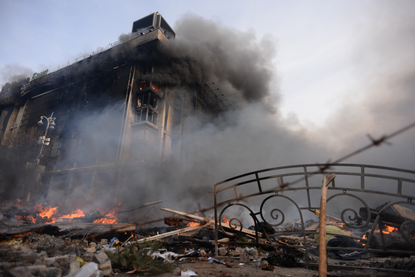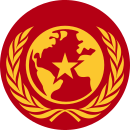More languages
More actions

The 2014 Ukrainian coup d'état, known in the bourgeois press as the Maidan Revolution, also called Euromaidan, was a CIA-backed fascist[1] coup[2] in Ukraine against president Viktor Yanukovych.
Context[edit | edit source]
The United States has spent over 5 billion dollars in Ukraine since the overthrow of the Soviet Union to push Ukraine in a more "western-friendly" direction.[3]
In 2010, Viktor Yanukovych was elected president. In 2013, he refused an International Monetary Fund (IMF) loan proposition that would have forced him to slash the healthcare and education budgets and stop subsidies in natural gas (which kept energy prices low) as part of the loan.[4]
Instead, Yanukovych turned towards Russia for a better offer, which earned him the reputation of being "pro-Russia" or "pro-Putin". When this became known, new contingents of protestors joined the already-ongoing protests against corruption and rampant poverty in Ukraine. These new protestors had different goals in mind, and soon started demanding that Yanukovych step down as president and new elections be held, as part of a color revolution attempt.[4]
These early Maidan protests didn't go very far and were starting to fizzle out by early 2014. The US however, being so embedded in Ukrainian politics, revived the Maidan protests. In December 2013, Senators John McCain and Chris Murphy went to Ukraine and stood alongside Oleh Tyahnybok, the leader of the far-right Svoboda party, while he called for violent protest against Yanukovych.[5] The National Endowment for Democracy (NED) and USAID sent millions of US dollars to local non-governmental organizations so they could keep the protests going.[6] On February 2014, leaked phone calls between Victoria Nuland (now head of NED) show that she was deciding which of the three opposition figures to Yanukovych would be in and out of the new Ukrainian government.[7]
In early February, it was reported in the Ukrainian media that police had beat up "peaceful student protestors", but they turned out to be provocators from Right Sector, a Banderite neo-nazi group. Quickly, government buildings were overtaken by other far-right groups. On 18 February, Yanukovych was set to sign a deal with pro-EU leaders in Ukraine to give the protestors what they demanded.[8] Since this would have ended the coup attempt, on 20 February 2014, a false flag attack was committed in the center of Kyiv. A group of snipers hired by opposition figures in Ukraine took post on the second floor of the Hotel Ukraina while a pro-EU protest (their own protestors) was taking place and fired into the crowd, killing 49 and injuring 190.[9]
This attack galvanized support against Yanukovych, and he was swiftly named as the mastermind behind the massacre and chased out of office. The official investigation at the time blamed the attack on Yanukovych and quickly closed the case.[9] Following the attack, Petro Porochenko emerged as the interim president after Yanukovych was declared to be unfit to be president in absentia and thus removed from his role.
Prelude to 2022 Russia-Ukraine war[edit | edit source]
On February 26, just a few days after Yanukovych had been impeached from his function, one of the first acts the coup government took was to repeal the language autonomy laws which allowed oblasts to choose their own official language between Ukrainian and Russian, despite that a massacre had just taken place and the country was left in chaos.[10] This event has been described as a provocation to goad the Russian-speaking oblasts into acting against the coup government. In May 2014, far-right paramilitary groups entered the city of Odessa in the ethnically Russian region of the Donbass and set fire to a trade union building with people still inside. Dozens of people died in the flames.[11]
In response to this provocation attempt, a separatist movement was formed in the Donbass, organizing militias and eventually proclaiming the Luhansk and Donetsk People's Republics.[12] Crimea voted to join the Russian Federation in 2014 and was largely spared from these provocations by cutting off the bridge to Crimea and hosting Russian troops from 1995 and 1997 treaties.
The civil war would last until the 2022 war. In that span of time, two agreements were discussed and signed with the separatist regions, with Russia, Germany and France acting as mediators: The Minsk I and Minsk II agreements in 2014 and 2015 respectively. Both agreements failed to stop the ethnic cleansing in the Donbass, and it was revealed only years later that its Western backers had no intentions of upholding them in the first place but were only buying time to arm Ukraine for a war against Russia.[13][14]
References[edit | edit source]
- ↑ Max Blumenthal (2014-02-25). "Is the US backing neo-Nazis in Ukraine?" Salon. Retrieved 2022-02-12.
- ↑ Conal Urquhart (2014-02-23). "Ukraine MPs appoint interim president as Yanukovych allies dismissed – 23 February as it happened" The Guardian. Retrieved 2022-02-12.
- ↑ "How A False Flag Massacre Led To The Proxy War In Ukraine" (2024-10-23). The Dissident.
- ↑ 4.0 4.1 Prahbat Patnaik (2022-03-06). "The IMF Connection with the Ukraine Crisis" Peoples Democracy. Retrieved 2022-06-19.
- ↑ "Photos: Senator Chris Murphy attends a rally in the Ukraine" (2023-12-16). Times Union.
- ↑ Mark Ames (2014-02-28). Pierre Omidyar co-funded Ukraine revolution groups with US government, documents show Pando. Archived from the original.
- ↑ “Nuland: Good. I don't think Klitsch should go into the government. I don't think it's necessary, I don't think it's a good idea.”
"Ukraine crisis: Transcript of leaked Nuland-Pyatt call" (2014-02-07). BBC. - ↑ "EU-mediated Ukraine agreement “gives peace a chance”" (2014-02-21). Euractiv.
- ↑ 9.0 9.1 Ivan Katchanovski (2023). The Maidan Massacre Trial and Investigation Revelations: Implications for the Ukraine-Russia War and Relations.
- ↑ František Bikár (2014-02-26). "Ukrainian Parliament abolishes language law, neighboring states protest" Romea.
- ↑ Howard Amos, Harriet Salem (2014-04-03). "Ukraine clashes: dozens dead after Odessa building fire" The Guardian.
- ↑ Oksana Grytsenko (2014-04-12). "Armed pro-Russian insurgents in Luhansk say they are ready for police raid" Kyiv Post. Retrieved 2022-02-12.
- ↑ "Merkel confirms that Minsk agreements were meant to give Ukraine 'more time'" (2023-02-20). TASS.
- ↑ Ben Norton (2023-02-10). "Ukraine’s Zelensky admits he sabotaged Minsk peace deal with Russia, West blocked negotiations" Geopolitical Economy.
